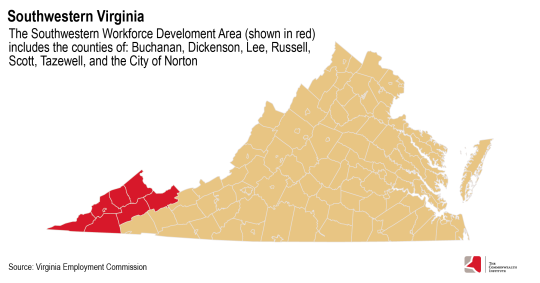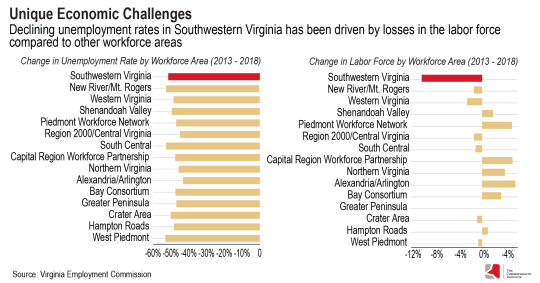July 12, 2019
Low Unemployment Masks Continued Economic Concerns for Southwestern Virginia
Ensuring that as many individuals with the ability to work have the opportunity to do so is a key indicator of a healthy economy. Not only should people in Virginia have access to jobs, those jobs should be stable and provide a sustainable source of income and opportunities for growth over time. Unfortunately, for some regions in the state, well-paying jobs are still hard to come by even with the appearance of economic progress.
That’s particularly true for Southwestern Virginia. Despite having the highest unemployment rate out of all areas within the state, the unemployment rate in Southwestern Virginia has dropped significantly over the last five years – from 9.2% in 2013 to 4.4% in 2018. However, this drop tells a misleading story. The lower unemployment rate can be explained by fewer people in the area looking for work, rather than increases in the number of those employed. Greater investments still need to be made in education and training, environmental protection programs, and supporting individuals with low incomes in order to diversify industries and provide more sustainable economic opportunity in Southwestern Virginia.

While the unemployment rate is used to give a snapshot of the economic climate, it only accounts for people who are not employed and searching for a job. Individuals no longer looking, those unable to work, and those leaving a particular region to pursue job opportunities elsewhere are not included in the unemployment rate for that region. Alternatively, the labor force includes all individuals who are able to work, both employed and unemployed. Compared to other workforce areas in Virginia, the change to the labor force in the southwestern area is striking. Between 2013 and 2018, Southwestern Virginia lost over 10% of its labor force – the most out of any area throughout the state and 4 times the loss of the area with the next sharpest decline. Although it is true that fewer people are searching for employment within Southwestern Virginia compared to 2013, it is largely driven by massive labor force loss, not because more people have found jobs, let alone high-paying jobs.

The local context within specific rural areas calls for locally-tailored policy solutions to address the economic needs of communities like Southwestern Virginia. The most apparent difference between this workforce area and other regions throughout the state is the continued decline of the coal industry. Between 2004 and 2014, Virginia’s coal production decreased by approximately half, translating to nearly 1,000 coal workers losing their jobs, adding to the even larger coal employment drops in the 1990s. This decline has only continued since then as Virginia’s annual production of coal dropped from 15.3 million tons in 2014 to 13.2 million tons in 2017, leading to further job loss. This is especially concerning for Southwestern Virginia as it is responsible for the entirety of the state’s coal production, 85% of which is produced in the counties of Buchannon, Dickenson, and Tazewell.
There are multiple tools, at both the federal and state level, that lawmakers can use to support and strengthen these communities. The RECLAIM Act is one potential remedy that has been proposed in Congress for the larger Appalachia region. This bill would allocate $195 million each year between 2020 and 2024 to certain projects in states within the Appalachia region, such as Kentucky, West Virginia, and Virginia. The act would empower and diversify local communities impacted by the declining coal industry by creating jobs to reclaim and restore land and water affected by coal mining. Not only would this spur economic development, it would also help to counteract environmental damage caused by coal mining at no additional cost to taxpayers (the money would come from an existing fund already set aside for the reclamation and restoration of land and water resources adversely affected by coal mining carried out before August 3, 1977).
Restoring the economy of Southwestern Virginia has its challenges. The shift from coal to cheaper natural gas and the increased use of renewable energy sources are primary factors for the declining value and demand for steam coal, which is used to produce electricity. And the prices for metallurgical coal, used for steel production, have dropped due to slowdowns in China’s rapid phase of industrialization, adding to Virginia’s challenges. The RECLAIM Act would help diversify the historically coal-dependent economy of Southwestern Virginia to be more resilient to drops in global demand for both steam and metallurgical coal.
Other remedies to help diversify the economy and spur growth within this region should also be explored, and health care may play a key part. Unlike the coal industry, employment levels for education and healthcare services are projected to increase by 20% from 2016 to 2026 within this workforce area. Yet those jobs won’t be filled unless there are qualified workers to do so. Greater state investment in training and education programs for healthcare professionals, through local community colleges for instance, would allow a greater number of people to learn skills within a secure and sustainable industry. At the same time, the health needs of those within the region would be better met. Research shows when people have better access to health care they are more able to obtain and maintain employment.
A more immediate method of providing an economic boost to families within Southwestern Virginia would be to adopt a refundable Earned Income Tax Credit (EITC) within the commonwealth. Currently, the state’s EITC is non-refundable, meaning that thousands of people in Virginia are not receiving the full value of the credit they earned. Because this workforce area has a median income level well below the state average, making the EITC refundable would bring a much needed leg up to individuals with some of the lowest incomes in the state. There are 17,800 households in the Southwestern workforce area who receive the federal EITC, many of whom would benefit from making the state version refundable.
Rather than improved economic conditions, the declining unemployment rate experienced within Southwestern Virginia over the last few years tells a grim story of labor force decline largely fueled by the steady demise of a once booming coal industry. These conditions make the Southwestern area unique compared to all other workforce areas throughout the state, calling for locally-tailored policy solutions. Transformative investments such as adoption of the RECLAIM Act, greater investment in education for health service occupations, and improving the state’s EITC are much needed. But they are just a start to restoring economic conditions and job prospects for those remaining along Virginia’s southwestern border.
Category:
Economic Opportunity

